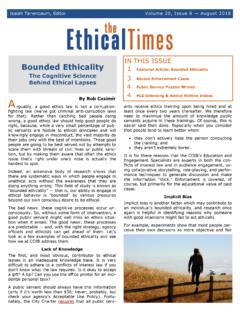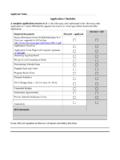Transcription of New York City Department of Health and Mental Hygiene ...
1 New york city Department of Health and Mental Hygiene local Law 73 implementation update for 2009 Prepared by the Office of Clinical Quality Management and Improvement, March 2010 In October 2004, the New york city Health Department published an implementation Plan to outline steps it would take to comply with local Law 73 of 2003. This implementation update describes activities undertaken during 2009 to provide limited English proficient (LEP) clients access to the agency s Health services. In 2009, there were 22 clinical sites covered under Article 28 which worked to comply with local Law 73. The agency s local Law 73/LEP Committee met quarterly to address issues related to language interpretation and translation services at these sites. The committee comprises representatives from the Office of Clinical Quality Management and Improvement (CQMI) and the Bureau of Communications, as well as the three bureaus that provide direct patient care services in Article 28 clinics: Bureau of Sexually Transmitted Disease Control (STDC), Bureau of Tuberculosis Control (TBC) and Bureau of Immunization (BOI).
2 update on 2009 Goals and Highlights In 2009, the agency completed a new Language Access Toolkit as a resource for clinic staff and managers that highlights protocols and tips for serving LEP clients. LEP Policy and Procedures were completed for all of the clinics. The agency created a multilingual customer service complaint line for clients to capture feedback on ways that the agency can improve client satisfaction. Identification of Primary Language The agency defines primary language as the language in which a client prefers to communicate when receiving services. All Article 28 clinics receive Language Access Toolkits that detail instructions on identifying clients primary language. In all of the clinics, staff use Free Interpretation Services posters to assist in language identification.
3 In addition, language identification cards and bilingual staff are used in most clinics. Language Assistance Services Telephone interpretation: All Article 28 clinics have access to Language Line, the agency vendor for telephone interpretation services. Dual-handset telephones are used at 82% of the clinical sites to support efficient and confidential exchanges. Speakerphones or mobile phones are used in the remaining sites. Translated materials: CQMI partners with PLA to ensure that patient education materials, bureau-specific forms and New york State Department of Health regulatory posters are translated in the languages most commonly used in each clinic. PLA coordinates translation services for the agency, primarily through professional translation vendors. New york city Department of Health and Mental Hygiene 2009 local Law 73 implementation update 2 Quality Assurance Measures The CQMI staff conducted a two-part LEP Review Site Survey in 2009.
4 The first part was conducted from July 2009 through August 2009 and the second part November 2009 through December 2009 at the 22 clinical sites administered by STDC, TBC and BOI. The review assessed the quality of multilingual staff, signage, methods of language identification, and usage of interpretation services. The findings indicated 100% of clinical staff members are trained to recognize when language interpretation services are required and know how to access them. Sites rely most on bilingual staff and Language Line to provide interpretation assistance. The agency strives to improve standardization in data collection across agency clinics. Both STDC and TBC clinics utilize an electronic medical records system that tracks the primary language and interpretation assistance need for every patient.
5 BOI clinics rely on paper-based encounter forms. Table 1 displays the intervals at which LEP statistics are reviewed at the 22 clinics. Table 1. Recurrence of Review for LEP Visit Statistics at Clinics STDC TBC Immunization Total Daily 0 3 0 3 Monthly 0 3 4 7 Annually 5 3 0 8 On subsequent client visit 1 0 0 1 Periodically 1 0 0 1 Not at all 2 0 0 2 Total # of clinics 9 9 4 22 The
6 Agency has worked to improve a seamless relay of interpretation services at every point of service (Table 2) in a client s visit. There is an average of four main points of service in the clinics. The triage station as one of the first points of service in all clinics, and all triage stations have access to Language Line and translated forms. Clinic staff members find out the patient s primary language at triage and then inform their colleagues at the next point of service. New york city Department of Health and Mental Hygiene 2009 local Law 73 implementation update 3 Table 2. Points of Service with Access to Interpretation Services Triage1 100% (22/22) Registration/Screening2 100% (22/22) QuantiFERON3/TST TBC Clinics Only 100% (9/9) Post vaccination waiting BOI Clinics Only 100% (4/4) Medical Evaluation/ Initial MD Evaluation/Vaccination 64% (14/22) Client and Staff Languages The clinics had 177,017 patients in 2009.
7 Of these, 57,128 ( ) had a primary language other than English and 35,194 ( ) required interpretation services, which is displayed in Table 3. Table 3. Clients Requiring Interpretation Services in Clinics STDC TBC Immunization Total Clients requiring interpretation services (1,983/85,991) (1,092/27,037) (32,119/63,989) (35,194/177,017) STDC clinics had a decrease in client volume because the East Harlem clinic was permanently closed in April 2009 and the Central Harlem clinic was temporarily closed in August 2009. The Central Harlem clinic will reopen in January 2010. TBC had a decrease in client volume because they discontinued the provision of TST tests to service employment prerequisites for clients. An increase in BOI interpretation services this year could be due to the increase in patient volume from the citywide H1N1 influenza vaccination campaign.
8 Overall, 100% (22/22) of clinics have multilingual employees who provide interpretation in at least one language of the LEP population they commonly serve. All of the clinics that have Spanish-speaking LEP clients have Spanish-speaking staff. The top two most common non-English languages spoken by staff are Spanish and Chinese. The third and fourth most common languages spoken by staff are French and French Creole, respectively. All clinics use Language Line when the patient can not be assisted by a bilingual staff member. 1 Triage is the first point of contact in an Article 28 clinic. It is where patient needs are initially assessed. 2 Registration/Screening is the station where patient-sensitive information is documented and needs are reviewed.
9 3 QuantiFERON and TST tests take place before a medical evaluation by the physician. New york city Department of Health and Mental Hygiene 2009 local Law 73 implementation update 4 Bureau of Sexually Transmitted Disease Control STDC clinics served 85,991 unique clients4 in 2009. Interpretation services are provided at five points of service in the nine STDC clinics. The top primary languages for the LEP client population at the nine STDC clinics are Spanish, Chinese, French and French Creole. Spanish staff interpreters are available at 100% of clinics with Spanish-speaking LEP clients. Figure 1 demonstrates the specific languages spoken by STDC clinic-based staff. Figure 1. Number of STDC clinic-based staff who speak a non-English language. 34973332222100510152025303540 SpanishFrenchHa itian CreolePatiosRus sia nYorubaArabicCantoneseItalianPortugueseO ther* * Other includes Tagalog, Amharic, Edo, Galician, Ibo, Mandarin, Nigerian, Ukrainian and Vietnamese 88% (7/8) of clinics with significant number of Chinese-speaking LEP clients have staff who speak Chinese dialects, and 75% (3/4) of clinics with French and French-Creole speaking LEP clients have French and French Creole-speaking staff.
10 Table 4 displays the top primary languages for non-English speaking STDC clients. Table 4. Primary Language of Patients in STDC Clinics Language 2009 Number of Clients % Total 2005 2008 Number of Clients % Total 2008 2007 Number of Clients % Total 2007 Spanish 12,532 12,237 9,889 Chinese 420 471 248 French 204 182 198 French Creole 148
















